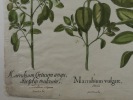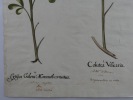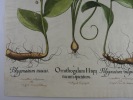8 books for « besler basilius »Edit
-
Topics
Botany (1)
Flora (2)
Flowers (1)
History (2)
Horticulture (4)
Tea (1)
-
Countries
Belgium (5)
France (2)
Switzerland (1)
-
Syndicate
ILAB (3)
SLAM (2)
BOTANIQUE - Gravure originale in-folio sur cuivre, imprimée sur papier vergé filigrané et aquarellée à la main, provenant du HORTUS EYSTETTENSIS de Basil Besler / Original Basil Besler's botanical copper engraving : I. MARRUBIUM VULGARE II. MARRUBIUM CRETICUM ANGU III. MENTHA SARRACENICA.
Eichstätt und Nürnberg, sd, 1613 ou 1640, 53x39,5cm (20,86 x 15,55 in), Gravure provenant du catalogue monumental Hortus Eystettensis publié par le botaniste, apothicaire et médecin, Basil Besler en 1613, à l'occasion de la création du jardin botanique commandé en 1597 par le prince-évêque d'Eichstätt, Jean Conrad de Gemmingen. L'ouvrage décrit 1084 espèces végétales et contient 367 planches des plantes les plus remarquables du jardin du prince, exécutées par plus de six graveurs différents et dont le plus important était Wolfgang Kilian. Pas de texte au verso. Numérotation à la plume "281" en haut à droite. Bel état de fraîcheur.
BOTANIQUE - Gravure originale in-folio sur cuivre, imprimée sur papier vergé filigrané et aquarellée à la main, provenant du HORTUS EYSTETTENSIS de Basil Besler / Original Basil Besler's botanical copper engraving : I. COLUTEA VESICARIA II. CYTISUS GALENI MARANTA. CORNUTUS III. CYTISUS PRIMUS TABERNEM SPICATUS
Eichstätt und Nürnberg, sd, 1613 ou 1640, 54x40,5cm (21,25 x 15,94 in), Gravure provenant du catalogue monumental Hortus Eystettensis publié par le botaniste, apothicaire et médecin, Basil Besler en 1613, à l'occasion de la création du jardin botanique commandé en 1597 par le prince-évêque d'Eichstätt, Jean Conrad de Gemmingen. L'ouvrage décrit 1084 espèces végétales et contient 367 planches des plantes les plus remarquables du jardin du prince, exécutées par plus de six graveurs différents et dont le plus important était Wolfgang Kilian. Pas de texte au verso. Numérotation à la plume "62" en haut à droite. Bel état de fraîcheur.
BOTANIQUE - Gravure originale in-folio sur cuivre, imprimée sur papier vergé filigrané et aquarellée à la main, provenant du HORTUS EYSTETTENSIS de Basil Besler / Original Basil Besler's botanical copper engraving : I. ORNITHOGALUM HISPA, NICUM SPICATUM II. POLYGONATUM VULGATIUS III. POLYGONATIUM MAIUS.
Eichstätt und Nürnberg, sd, 1613 ou 1640, 54x40,5cm (21,25 x 15,94 in), Gravure provenant du catalogue monumental Hortus Eystettensis publié par le botaniste, apothicaire et médecin, Basil Besler en 1613, à l'occasion de la création du jardin botanique commandé en 1597 par le prince-évêque d'Eichstätt, Jean Conrad de Gemmingen. L'ouvrage décrit 1084 espèces végétales et contient 367 planches des plantes les plus remarquables du jardin du prince, exécutées par plus de six graveurs différents et dont le plus important était Wolfgang Kilian. Pas de texte au verso. Numérotation à la plume "141" en haut à droite. Bel état de fraîcheur.
BOTANIQUE - Gravure originale in-folio sur cuivre, imprimée sur papier vergé filigrané et aquarellée à la main, provenant du HORTUS EYSTETTENSIS de Basil Besler / Original Basil Besler's botanical copper engraving : I. SALVIA MAIORLATIFOLIIS FLORE CAERULEO II. SALVIA HISPANICA FLORE ALBO III. SALVIA MINOR PINNATA.
Eichstätt und Nürnberg, sd, 1613 ou 1640, 53x39cm (20,86 x 15,55 in), Gravure provenant du catalogue monumental Hortus Eystettensis publié par le botaniste, apothicaire et médecin, Basil Besler en 1613, à l'occasion de la création du jardin botanique commandé en 1597 par le prince-évêque d'Eichstätt, Jean Conrad de Gemmingen. L'ouvrage décrit 1084 espèces végétales et contient 367 planches des plantes les plus remarquables du jardin du prince, exécutées par plus de six graveurs différents et dont le plus important était Wolfgang Kilian. Pas de texte au verso. Numérotation à la plume "141" en haut à droite. Bel état de fraîcheur.
L'herbier des quatre saisons ou le jardin d'Eichstätt
Ed. Mazenod, Paris, 1987 - in-folio, reliure éditeur pleine toile, jaquette et étui illustrés, ouvrage non paginé, 367 planches couleurs pleine page, chaque planche est préalablement commentée, préface de Pierre Gascar, textes de Gérard G. Aymonin, index hors texte in fine, 762 illustrations au total (dont 390 en couleurs) - première édition, ouvrage en parfait état, étui légèrement défraichi (petite mouillure sur une tranche) - Publié pour la première fois en 1613, cet herbier répertorie plus de 1000 plantes représentant 607 espèces
L'herbier des quatre saisons ou le jardin d'Eichstätt
1987 Ed. Mazenod, Paris, 1987 -fort volume in-folio, reliure éditeur pleine toile, jaquette et étui illustrés, ouvrage non paginé, 367 planches couleurs pleine page, chaque planche est préalablement commentée, préface de Pierre Gascar, textes de Gérard G. Aymonin, index hors texte in fine, 762 illustrations au total (dont 390 en couleurs) - première édition, ouvrage en parfait état. publié pour la première fois en 1613, cet herbier répertorie plus de 1000 plantes représentant 607 espèces
Hortus Eystettensis. (Faksimile der Ausgabe 1713).
München, Konrad Kölbl, 1964. Folio. Ca. 900 S. Orig.-Kunstlederband.
Garden at Eichst tt 3 vols.
, Taschen, 2024 Hardcover, 3 vols. in slipcase, 24.3 x 30.4 cm, 6.54 kg, 1096 pages, Edition: English, French, German. ISBN 9783836594332.
The 367 exquisite hand-colored plates of the Hortus Eystettensis, published in 1613 with elaborate descriptions to record the palatial gardens in Eichst tt, Bavaria, were a landmark in botanical illustration. This facsimile edition, featuring authoritative texts and a present-day classification, preserves a treasured florilegium for posterity.- A complete facsimile edition of the three-volume Hortus Eystettensis When Prince-Bishop Johann Konrad von Gemmingen (1593/95?1612) undertook a radical renovation of the Willibaldsburg Castle, overlooking the Altm hl River in Eichst tt, Bavaria, he also created a surrounding palatial pleasure garden of magnificence and grandeur. To preserve the garden for future generations ? and provide an ?evergreen? record of its contents, compiling plants from all four seasons and presenting them in that order ? he commissioned the garden?s director, Nuremberg apothecary Basilius Besler (1561?1629), and a team of engravers to immortalize its treasures in print. The resulting Hortus Eystettensis, published in Nuremberg in 1613 and containing 367 hand-colored plates and detailed descriptions, was a work of meticulous execution and spectacular diversity, and remarkably expensive for its time. As the garden contained a variety of plants imported from exotic locales, the three volumes exhibited a remarkable range, covering a total of 90 families and 340 genera. Due to the decorative, stylized execution of these illustrations, which began to see plants in aesthetic, rather than merely practical or medicinal terms, the book is seen as a milestone in the art of botanical illustration. While published before a time of standardized classification systems, it was nonetheless later described by Carl Linnaeus as an ?incomparable work?. Besler?s catalog long outlived the gardens, which were destroyed in 1634 by invading Swedish troops during the Thirty Years? War. However, a lengthy redevelopment project at the historic site has culminated in the opening of the modern Bastion Garden in 1998, containing many of the plants shown in the Hortus Eystettensis. Offering high-quality reproductions of these arresting illustrations, based on the copy of the Hortus Eystettensis at the University Library of Eichst tt-Ingolstadt, this facsimile edition is accompanied by detailed plate descriptions of each plant?s botanical, pharmaceutical, and symbolic significance and an appendix of further essays which place the garden and the book in their historical contexts. This edition presents a valuable piece of botanical literature which, on the rare occasions where a copy appears on the market, can fetch prices of over $1,000,000 at auction. In line with Besler?s original intentions, this facsimile unfurls the garden to a wider audience and captures it for posterity.
 Write to the booksellers
Write to the booksellers














